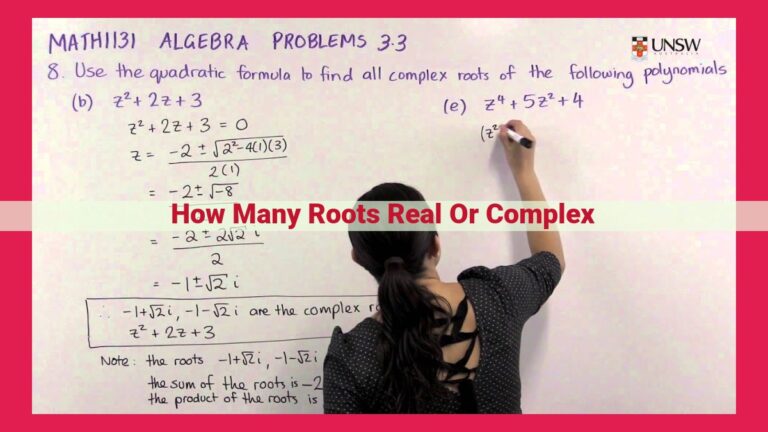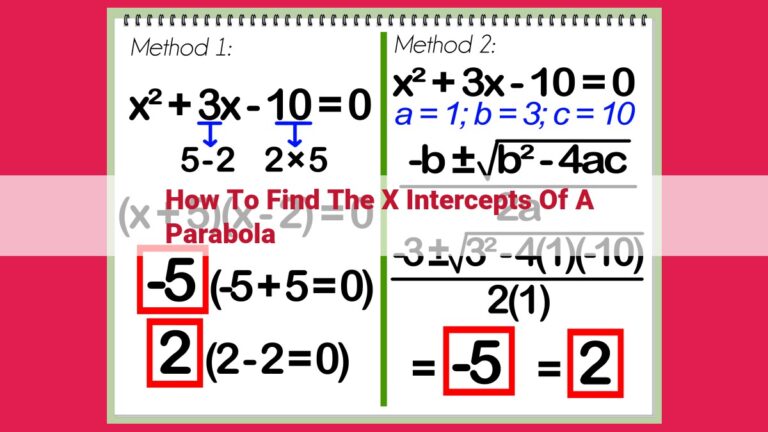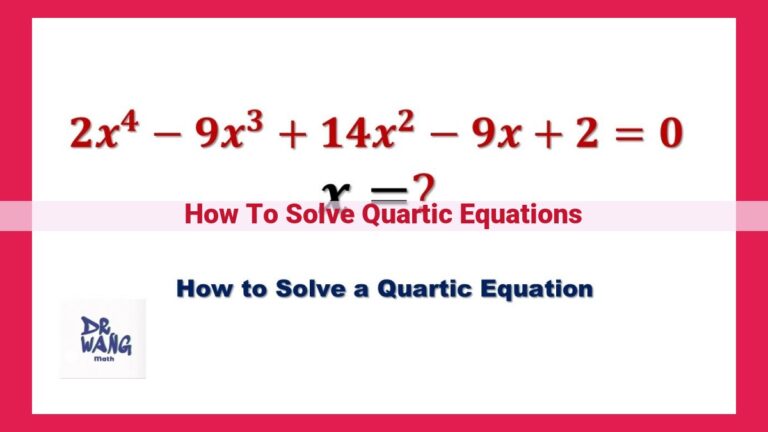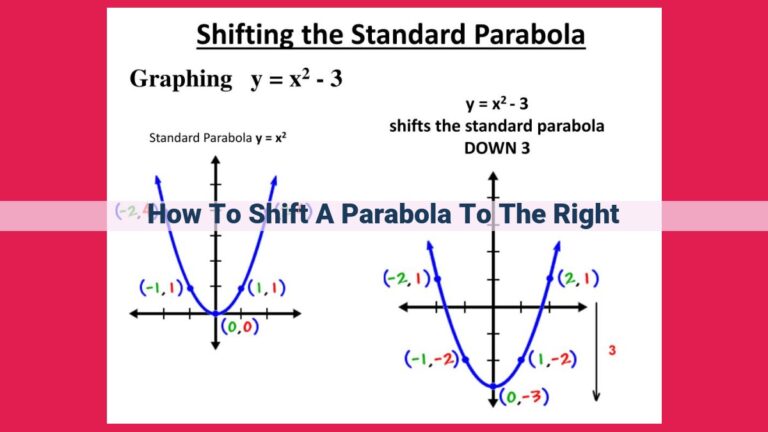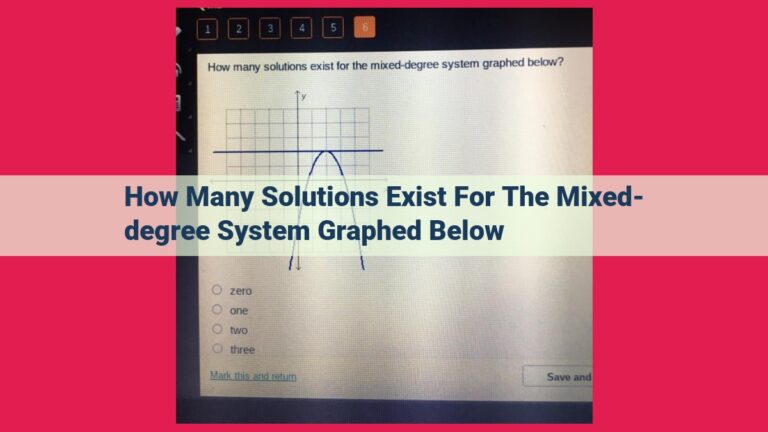Mastering Cartesian Equations Of Lines: Slope, Distance, And Midpoint Formulas
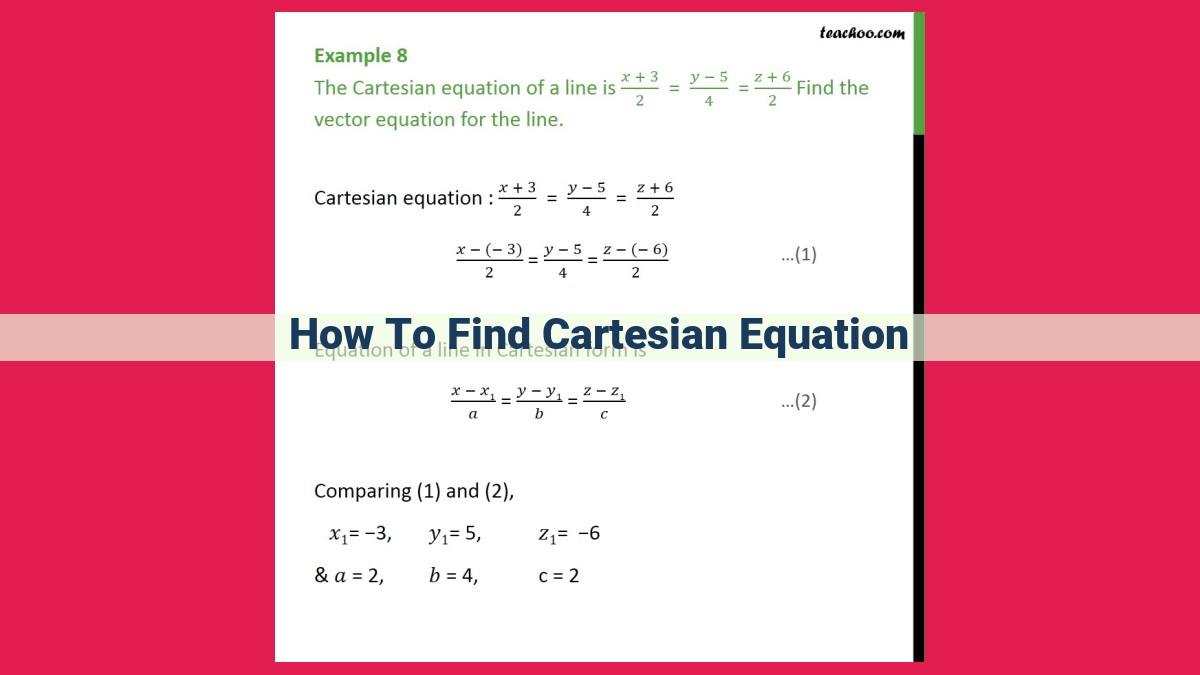
To find the Cartesian equation of a line, first determine its coordinates and slope. Use the slope-intercept form (y = mx + b) if you have the slope and y-intercept. Alternatively, use the point-slope form (y – y1 = m(x – x1)) if you have a point and slope. Another option is the two-point form (y – y1 = (y2 – y1) / (x2 – x1) * (x – x1)) if you have two points. To find the distance between two points, use the distance formula (d = √((x2 – x1)^2 + (y2 – y1)^2)). Lastly, for the midpoint of a line, employ the midpoint formula ((x1 + x2) / 2, (y1 + y2) / 2).
Understanding Cartesian Coordinates: Unlocking the Map of the Plane
Imagine you’re a cartographer tasked with charting an unexplored land. To precisely locate and describe the various points and lines that define this new territory, you need a system that can accurately represent their positions. Enter Cartesian coordinates, the ingenious tool that unlocks the mapping of the plane.
Coordinate Plane: The Canvas of Points and Lines
Think of the coordinate plane as a giant canvas, where each point is assigned two coordinates, a horizontal x-coordinate and a vertical y-coordinate. These coordinates are like the longitude and latitude of the plane, providing precise locations for every point. The intersection of the vertical and horizontal axes creates four distinct quadrants, each representing a specific combination of positive and negative values for x and y.
Navigating the Plane with Linear Equations
With the coordinate plane as our guide, we can now explore the realm of lines. Linear equations, which take the form of y = mx + b, describe these lines, where m represents the line’s slope and b is its y-intercept. The slope tells us how steeply the line rises or falls as we move from left to right, while the y-intercept pinpoints where the line intersects the y-axis.
Unlocking the Power of Slope and Intercept
The slope and y-intercept provide valuable insights into a line’s characteristics. The slope reveals whether a line is horizontal (slope of 0), vertical (slope is undefined), or sloped. The y-intercept, on the other hand, indicates where the line crosses the y-axis. These two parameters allow us to quickly sketch and describe lines with precision.
Beyond Slope-Intercept Form
While the slope-intercept form is often the most familiar, Cartesian coordinates offer additional tools for representing lines. Point-slope form utilizes a given point and the line’s slope to write its equation, while two-point form harnesses two distinct points to establish a line’s equation. These alternative forms provide flexibility and convenience in specific situations.
Quantifying Distance and Midpoints
The coordinate plane also empowers us to measure and analyze distances and midpoints. The distance formula calculates the distance between two points, while the midpoint formula finds the exact midpoint of a line segment. These formulas are essential for solving geometric problems and understanding the spatial relationships between points and lines.
Coordinate Plane
- Describe the concept of a coordinate plane and its four quadrants.
Coordinate Plane: The Blueprint for Graphing Equations
In the realm of mathematics, the coordinate plane stands as a fundamental tool for graphing equations and visualizing geometric relationships. Imagine an expansive canvas, where every point is uniquely defined by a pair of numbers called coordinates. These coordinates, represented as (x, y), tell us the distance and direction from the origin, the point where the x- and y-axes meet.
The x-axis runs horizontally, separating the plane into two halves: the positive side to the right and the negative side to the left. The y-axis, on the other hand, runs vertically, dividing the plane into the upper half and the lower half. Together, they form a rectangular grid that serves as the backdrop for our equations.
Within this grid, the coordinate plane is further divided into four quadrants. The first quadrant lies in the upper right corner, where both x and y are positive. The second quadrant is in the upper left corner, where x is negative and y is positive. The third quadrant is in the lower left corner, where both x and y are negative. Finally, the fourth quadrant is in the lower right corner, where x is positive and y is negative.
Understanding the coordinate plane is the linchpin for visualizing and interpreting equations. It allows us to represent points, lines, and other geometric shapes with precision, enabling us to explore mathematical concepts in a tangible and interactive way.
Slope-Intercept Form
- Define slope and y-intercept.
- Explain how to write a linear equation in slope-intercept form (y = mx + b) and interpret its meaning.
Understanding the Slope-Intercept Form: A Linear Equation in Plain Sight
In the realm of mathematics, linear equations hold a special place as they describe the simplest of relationships between variables. One of the most fundamental forms of a linear equation is the slope-intercept form, an equation that showcases the slope and y-intercept of a line.
The Allure of Slope: Measuring a Line’s Inclination
Imagine a road winding its way through a landscape. As you traverse this path, you notice how it rises or falls, creating a sense of inclination. This inclination is captured by a numerical value called slope, which tells us how steep or flat the line is. In the world of linear equations, slope is represented by the letter m.
Y-Intercept: Where the Line Meets the Y-Axis
When the road touches the ground, it creates a point of contact with the y-axis. This point is known as the y-intercept, denoted by the letter b. The y-intercept represents the value of y when x is zero, providing us with a glimpse of where the line crosses the y-axis.
Slope-Intercept Form: Putting It All Together
With slope and y-intercept in our vocabulary, we can now construct the slope-intercept form of a linear equation: y = mx + b. This equation is like a blueprint for a line, where m tells us its steepness and b reveals where it intersects the y-axis.
To illustrate, consider the equation y = 2x + 3. The slope, m, is 2, indicating that for every unit increase in x, y increases by 2 units. The y-intercept, b, is 3, telling us that the line crosses the y-axis at the point (0, 3).
Grasping the Meaning: Interpreting the Equation
The slope-intercept form not only describes the line’s geometry but also holds valuable information. The slope, m, provides insights into the line’s direction: positive slopes indicate upward lines, while negative slopes signify downward lines. The y-intercept, b, on the other hand, gives us a direct measure of the line’s vertical displacement from the origin.
In essence, the slope-intercept form of a linear equation is a powerful tool that enables us to describe, analyze, and visualize the simplest of relationships between variables. It’s a cornerstone of linear algebra, providing a foundation for understanding more complex mathematical concepts.
Point-Slope Form: A Tailor-Made Equation for Lines
In the realm of linear algebra, the point-slope form provides a unique and intuitive way to describe the equation of a line. Unlike the slope-intercept form (y = mx + b), which assumes a line passes through the origin, the point-slope form takes into account any given point on the line.
Writing a Point-Slope Equation
To write a linear equation in point-slope form, you need two essential pieces of information: the slope (m) and a specific point (x1, y1) on the line. The equation is written as:
y - y1 = m(x - x1)
Here, y represents the unknown y-coordinate of any arbitrary point on the line, and x represents its x-coordinate. y1 is the y-coordinate of the given point, x1 is its x-coordinate, and m is the slope of the line.
Significance of a Given Point and Slope
The significance of the given point and slope in the point-slope form is that they uniquely determine the line that the equation represents. The point serves as a reference point, while the slope describes the direction and steepness of the line.
For instance, if we have a point (2, 3) on a line with slope 1, the point-slope form equation would be:
y - 3 = 1(x - 2)
This equation describes exactly one line, which passes through point (2, 3) and has a slope of 1. Any other point on this line can be determined by substituting different values of x into the equation.
Benefits of Point-Slope Form
The point-slope form has several advantages:
- Flexibility: It can be used to describe any line, regardless of whether it passes through the origin.
- Intuitive: It’s easy to understand and interpret, as it directly relates to a specific point and the line’s direction.
- Useful for Graphing: By plotting the given point and using the slope to determine the direction, you can quickly sketch the line without needing to find the y-intercept.
The point-slope form is a versatile and practical way to represent linear equations. It provides a clear understanding of the relationship between a line’s slope and a given point, making it a valuable tool for solving a variety of algebra problems.
Unlocking the Secrets of the Two-Point Form: A Linear Equation Adventure
In the captivating world of mathematics, where numbers dance and equations sing, we embark on a thrilling quest to explore the mysteries of the Two-Point Form. This magical formula holds the power to unveil the secrets hidden within a linear equation, revealing its path through the coordinate plane.
Picture this: you’re given two points, like two twinkling stars in the night sky. These points represent the footsteps of a line, marking its existence. The Two-Point Form provides us with a roadmap, a set of instructions on how to construct this line, transforming those two points into a tangible equation.
With the given points, let’s call them Point A and Point B, we embark on our adventure. Imagine Point A as a treasure chest, filled with the coordinates (x1, y1). Point B is another treasure chest, holding the coordinates (x2, y2). The Two-Point Form formula is our treasure map, guiding us to discover the equation that binds these two points.
The formula reads like a secret incantation:
**y - y1 = (y2 - y1) / (x2 - x1) * (x - x1)**
Let’s break it down. y1 represents the y-coordinate of Point A, and x1 its x-coordinate. Similarly, y2 and x2 represent the coordinates of Point B. The difference y2 – y1 represents the vertical change from Point A to Point B, while x2 – x1 signifies the horizontal change.
The secret lies in the fraction: (y2 – y1) / (x2 – x1). This value is the slope of the line, a measure of its steepness or incline. It tells us how much y changes for every unit change in x.
The last step is to substitute x with any value that lies on the line. This is akin to placing a magnifying glass at different points along the line, allowing us to see its equation more clearly.
With the Two-Point Form, we’ve unlocked the secrets of linear equations. We can now determine the equation of a line given just two points, just as a cartographer charts a path between two distant landmarks. The coordinate plane becomes our canvas, and the equations we write paint vibrant lines that connect the dots, revealing the underlying patterns of mathematics.
Unlocking the Secrets of Cartesian Coordinates: Navigating the Coordinate Plane
In the realm of mathematics, Cartesian coordinates reign supreme as a powerful tool for describing the locations of points and lines in a plane. Imagine a vast grid, adorned with equally spaced horizontal and vertical lines, creating an intricate tapestry of squares. Each point on this grid can be precisely pinpointed using a pair of numbers, just like an address in the real world.
The Coordinate Plane: A New Perspective
The Cartesian coordinate plane is like a map with two axes: the x-axis and the y-axis. These axes intersect at a central point called the origin, dividing the plane into four regions known as quadrants. Each quadrant is labeled with Roman numerals (I, II, III, IV) and has its own unique characteristics based on the signs of the coordinates.
Slope-Intercept Form: Capturing Linear Relationships
Linear equations are the mathematical workhorses for describing straight lines. The slope-intercept form (y = mx + b) is particularly convenient. The slope (m) measures the steepness of the line, telling us how much the line rises or falls as we move along the x-axis. The y-intercept (b) represents the point where the line crosses the y-axis.
Point-Slope Form: When a Point and Slope Guide the Way
Another useful form of a linear equation is the point-slope form (y – y1 = m(x – x1)). Here, a known point (x1, y1) and the slope (m) are used to define the equation. This form is particularly handy when we need to write an equation given only a point and its slope.
Two-Point Form: Connecting Two Points with a Line
If we have two points (x1, y1) and (x2, y2) on a line, the two-point form (y – y1 = (y2 – y1) / (x2 – x1) * (x – x1)) can be used to find the equation. This form highlights the relationship between the two given points and the line they belong to.
Distance Formula: Measuring Separations in the Plane
Sometimes we need to determine the distance between two points on the coordinate plane. The distance formula (d = √((x2 – x1)^2 + (y2 – y1)^2)) comes into play here. It calculates the Euclidean distance between the two points (x1, y1) and (x2, y2). Understanding distance is crucial for applications such as finding the length of a line segment or the perimeter of a shape.
Midpoint Formula: Locating the Middle Ground
Another valuable tool in our Cartesian coordinate toolbox is the midpoint formula (((x1 + x2) / 2, (y1 + y2) / 2)). This formula finds the exact midpoint of a line segment with endpoints (x1, y1) and (x2, y2). Knowing the midpoint can be helpful for dividing a segment into equal parts or finding the center of a figure.
Cartesian coordinates provide a powerful and versatile language for describing points, lines, and distances on a plane. By understanding and utilizing these concepts, we can unlock a deeper understanding of geometry and its applications in the real world. From navigating a map to calculating distances in physics, Cartesian coordinates play an indispensable role in our mathematical pursuits.
Midpoint Formula
- Define the midpoint of a line segment.
- Present the midpoint formula ((x1 + x2) / 2, (y1 + y2) / 2) and explain its use in finding the midpoint of a line.
The Midpoint Formula: Finding the Heart of a Line Segment
In the realm of geometry, we often encounter line segments, which are defined by two endpoints. Determining the middle point of a line segment can be crucial for various calculations and constructions. Here’s where the midpoint formula comes to our aid.
Defining the Midpoint
The midpoint of a line segment is the point that divides the segment into two equal parts. In other words, it’s the exact center point between the endpoints. This point serves as a key reference point for analyzing and manipulating line segments.
The Midpoint Formula
The midpoint formula provides a mathematical means to find the coordinates of the midpoint. Given the endpoints of a line segment, say point A at (x₁, y₁) and point B at (x₂, y₂), the midpoint formula is:
Midpoint = ((x₁ + x₂) / 2, (y₁ + y₂) / 2)
This formula calculates the average of the x-coordinates and the average of the y-coordinates of the endpoints. The resulting coordinates represent the location of the midpoint.
Using the Midpoint Formula
To find the midpoint of a line segment, simply plug in the x and y coordinates of the endpoints into the midpoint formula. For instance, if A is at (1, 3) and B is at (5, 7), the midpoint would be:
Midpoint = ((1 + 5) / 2, (3 + 7) / 2)
= (3, 5)
This tells us that the midpoint of the line segment AB is at the point (3, 5).
Applications of the Midpoint Formula
The midpoint formula finds many applications in geometry and other fields. It can be used to:
- Determine the center of a circle by finding the midpoint of any two diameters.
- Partition a line segment into equal segments.
- Find the point of intersection of two perpendicular bisectors of a line segment.
- Calculate the centroid (geometric center) of a polygon.
The midpoint formula is a fundamental tool in geometry that provides a precise and straightforward way to locate the midpoint of a line segment. Understanding this formula empowers us to solve a wide range of problems and gain valuable insights into the nature of line segments.
